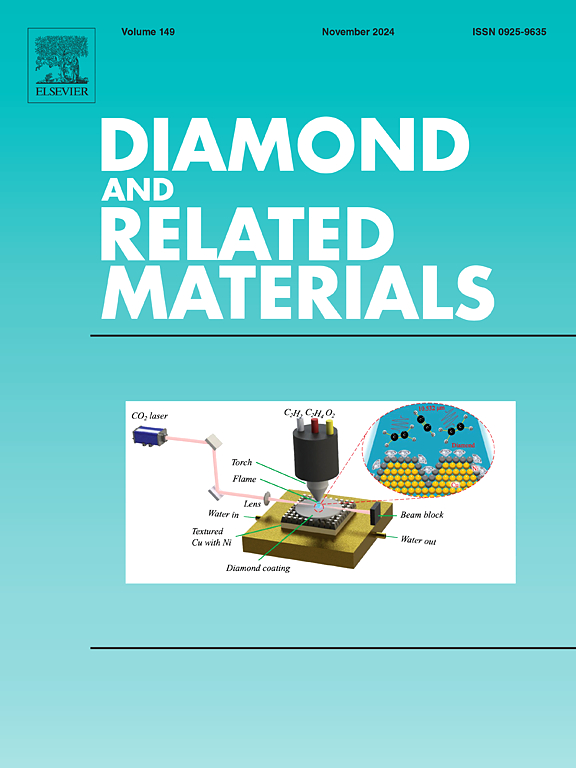利用MgO纳米立方揭示金刚石的n型表面电荷转移掺杂:第一性原理研究
IF 4.3
3区 材料科学
Q2 MATERIALS SCIENCE, COATINGS & FILMS
引用次数: 0
摘要
超宽带隙金刚石在半导体技术中的应用依赖于对载流子类型和密度的精确控制。然而,由于金刚石具有较强的共价键和较深的给体水平,传统的n型体掺杂仍然是困难的。表面电荷转移掺杂(SCTD)利用掺杂剂和半导体之间的能级差异,避免了活化能,提供了一种很有前途的替代方案。虽然有机分子和碱金属作为表面掺杂剂可以在氧端金刚石(100)表面实现n型掺杂,但它们的热稳定性和化学不稳定性阻碍了器件的长期稳定性。在这项工作中,我们使用第一性原理计算来研究n型SCTD在氧端金刚石(100)表面上使用MgO纳米立方体作为稳定的电子给体。MgO实现了有效的电子转移,将费米能级(0 k的最高占据电子态)转移到导带,从而证实了n型掺杂的成功。最大面电子密度达到1.98 × 1013 cm−2,与有机掺杂(~2.60 × 1013 cm−2)相当,比碱金属掺杂(~2.50 × 1014 cm−2)低一个数量级,稳定性显著提高。掺杂性能可通过金刚石和氧化镁层的厚度,以及纳米立方体的尺寸和密度来调节。此外,MgO通过引入0.4 eV的吸收峰增强了金刚石的红外响应,吸收系数为7 × 103 cm−1。这些结果为稳定、可调的n型掺杂提供了原子水平的见解,并指出氧化镁修饰的金刚石表面是中红外光电应用的有前途的候选者。本文章由计算机程序翻译,如有差异,请以英文原文为准。

Unveiling n-type surface charge transfer doping of diamond via MgO nanocubes: A first-principles study
The application of ultra-wide bandgap diamond in semiconductor technologies relies on precise control of carrier type and density. However, conventional n-type bulk doping remains difficult due to diamond's strong covalent bonds and deep donor levels. Surface charge transfer doping (SCTD) offers a promising alternative by exploiting energy-level differences between dopants and the semiconductor, avoiding activation energy. While organic molecules and alkali metals as surface dopants can achieve n-type doping on oxygen-terminated diamond (100) surfaces, their thermal and chemical instabilities hinder long-term device stability. In this work, we use first-principles calculations to investigate n-type SCTD on oxygen-terminated diamond (100) surfaces using MgO nanocubes as stable electron donors. MgO enables efficient electron transfer, shifting the Fermi level—the highest occupied electronic state at 0 K—into the conduction band, thereby confirming successful n-type doping. The maximum areal electron density reaches 1.98 × 1013 cm−2—comparable to organic doping (~2.60 × 1013 cm−2) and about one order lower than alkali metal doping (~2.50 × 1014 cm−2)—with significantly improved stability. The doping performance is tunable via the thickness of the diamond and MgO layers, as well as nanocube size and density. Additionally, MgO enhances the infrared response of diamond by introducing a 0.4 eV absorption peak with an absorption coefficient of 7 × 103 cm−1. These results offer atomic-level insights into stable, tunable n-type doping and point to MgO-modified diamond surfaces as promising candidates for mid-infrared optoelectronic applications.
求助全文
通过发布文献求助,成功后即可免费获取论文全文。
去求助
来源期刊

Diamond and Related Materials
工程技术-材料科学:综合
CiteScore
6.00
自引率
14.60%
发文量
702
审稿时长
2.1 months
期刊介绍:
DRM is a leading international journal that publishes new fundamental and applied research on all forms of diamond, the integration of diamond with other advanced materials and development of technologies exploiting diamond. The synthesis, characterization and processing of single crystal diamond, polycrystalline films, nanodiamond powders and heterostructures with other advanced materials are encouraged topics for technical and review articles. In addition to diamond, the journal publishes manuscripts on the synthesis, characterization and application of other related materials including diamond-like carbons, carbon nanotubes, graphene, and boron and carbon nitrides. Articles are sought on the chemical functionalization of diamond and related materials as well as their use in electrochemistry, energy storage and conversion, chemical and biological sensing, imaging, thermal management, photonic and quantum applications, electron emission and electronic devices.
The International Conference on Diamond and Carbon Materials has evolved into the largest and most well attended forum in the field of diamond, providing a forum to showcase the latest results in the science and technology of diamond and other carbon materials such as carbon nanotubes, graphene, and diamond-like carbon. Run annually in association with Diamond and Related Materials the conference provides junior and established researchers the opportunity to exchange the latest results ranging from fundamental physical and chemical concepts to applied research focusing on the next generation carbon-based devices.
 求助内容:
求助内容: 应助结果提醒方式:
应助结果提醒方式:


